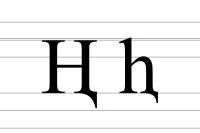H with descender
H with descender (Ⱨ ⱨ) is a letter of the Latin alphabet, derived from H with the addition of a small descender. It was used in Uyghur to represent [h] (~ English h), while a regular H was used to represent [x] (~ German ch in ach).[1]

This letter was in use from the early 1960s, when a Latin alphabet, the Uyghur New Script, was introduced for writing Uighur to replace the Arabic script, until 1984–86 when the Latin alphabet was phased out and the official script was changed back to Arabic. The equivalent Arabic letter is ھ, while the Cyrillic equivalent is the shha (Һ һ).
The capital letter is homoglyphic to the Cyrillic letter en with descender (Ң ң) used in various Turkic languages, including Uyghur itself in its own Cyrillic alphabet. Its lowercase form is homoglyphic with the shha with descender used in the Tati and Juhuri languages.
Computing codes
| character | Ⱨ | ⱨ | ||
| character encoding | decimal | hex | decimal | hex |
| Unicode | 11367 | 1U+2C67 | 11368 | 2U+2C68 |
| UTF-8 | 226 177 167 | E2 B1 A7 | 226 177 168 | E2 B1 A8 |
| HTML numeric | Ⱨ | Ⱨ | ⱨ | ⱨ |
- 1 Unicode name: LATIN CAPITAL LETTER H WITH DESCENDER
- 2 Unicode name: LATIN SMALL LETTER H WITH DESCENDER
- Ⱨ was added to Unicode in version 5.0 (2006).
See also
References
- Janbaz, Waris Abdukerim; Saleh, Imad; Duval, Jean Rahman. "An Introduction to Latin-Script Uyghur" (PDF). uyghurdictionary.org. p. 8. Archived from the original (PDF) on 11 October 2017. Retrieved 8 September 2023.